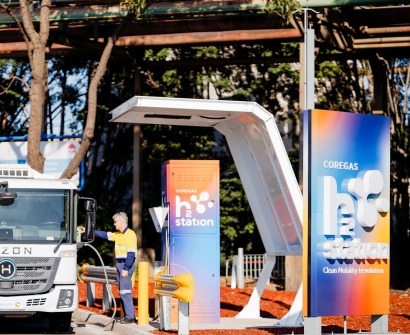
The Coregas H2Station, installed on the Bluescope Steel site, will be used to fill heavy hydrogen fuel-cell powered vehicles, including HGVs, buses, and refuse vehicles.
Haskel, based in Sunderland, UK, has provided Coregas with its turnkey GENO hydrogen refueling station solution. The refueling station is a reliable, high-capacity filling solution designed for highly demanding refueling profiles. It delivers a back-to-back filling experience, with the capacity to provide over 400kg of hydrogen per day. The system, optimized for Coregas, will take hydrogen from the production plant, compress it to 350 bar, and deliver it to a dispenser at the vehicle fueling station 50 meters away.
The Haskel compression technology for hydrogen vehicles delivers the same refueling ease as traditional petroleum and diesel refueling stations, making the transition as easy as possible for users.
Stewart Anderson, Haskel’s Hydrogen Business Development and Technical Sales Manager (APAC) said: “Haskel are proud to be working with Coregas to support the adoption of hydrogen technology in Australia’s transport sector. We are pleased to collaborate on this ground-breaking project, bringing our extensive high pressure gas experience and expertise in the hydrogen mobility sector to Port Kembla.”
“We’re proud to be working with Haskel on Coregas’ H2Station, an industry-leading initiative,” said Alan Watkins, Executive General Manager at Coregas in Australia. “The Haskel Hydrogen system features world-leading compression, storage and dispensing equipment specifically designed and optimized for H2Station. Transitioning our fleet to FCEVs is a cornerstone of the company’s decarbonization roadmap.”
Access to hydrogen fuel and refueling infrastructure are key enablers for the adoption of hydrogen as a zero-emission vehicle fuel alternative in the sector. After the successful launch of the first Haskel hydrogen refueling station on Australia’s West coast, this refueling station will start the transformation of the region’s transport environmental footprint by enabling the deployment of a fleet of hydrogen-powered prime mover vehicles in the region.

